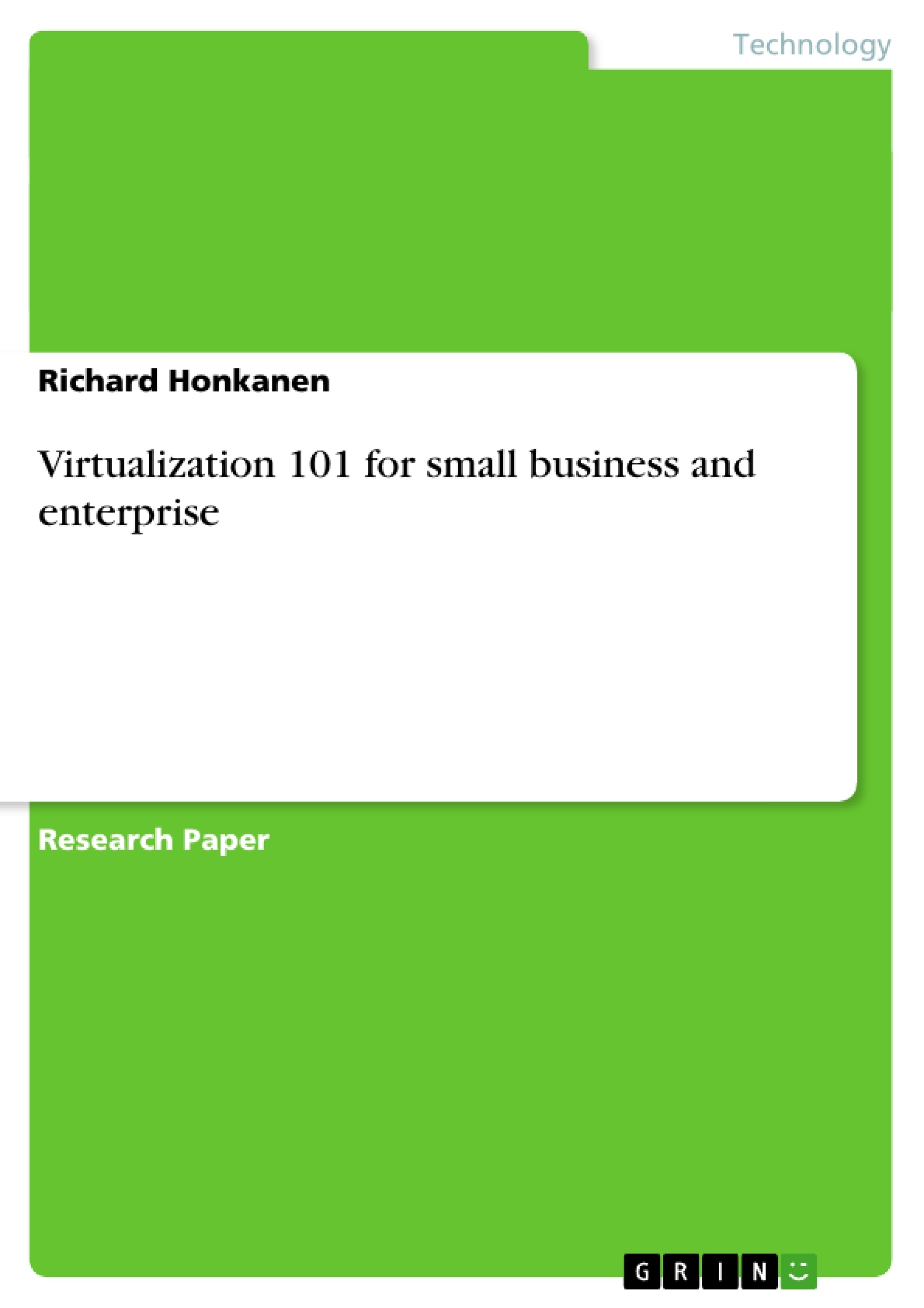Excerpt
Table of Contents
Executive Summary
Introduction
Background and Purpose
Scope and Limitations
Methodology
Thesis
Report Organization
Virtualization 101
What is Virtualization?
Who is Virtualization for? Why?
The Four Pillars of Virtualization
Compatibility
Isolation
Encapsulation
Hardware Independence
Common Questions
Is virtualization a fad?
Is virtualization more efficient, productive, and cost-effective in the long run?
Does virtualization replace the need for small business to have tech-support on payroll?
Are the cost savings for enterprise negligible?
Where is virtualization at today, and is it useful in its current form?
Applications of Virtualization
Business Continuity and Disaster Recovery
Cloud Computing
Load-Balancing
Security Concerns
Pros and Cons of Virtualization
Conclusion
Works Cited
Virtualization 101
for Small Business and Enterprise
ExecutiveSummary
Background and Purpose
Virtualization is a new and emerging technology that is rapidly growing, taking industry by storm. In business, virtualization has become a new buzz word, but not many decision-makers actually understand what it is. In today’s fiercely competitive world, it is crucial for decision- makers to learn more about virtualization to see if it can give their organizations leverage over their competition. Not only that, virtualization can save businesses of all sizes a lot of money.
Findings and Recommendations
Summed up in one sentence, virtualization is an information technology (IT) logistics strategy that can save businesses time and money. Today, most IT data centers use one machine for one server (e.g. one machine to serve e-mail, one for data, one for the website, etc.), causing server sprawl. Eventually businesses run out of room for new machines, leaving them stuck in a bad position. With virtualization, each server’s programs, files, and processes are merged into one file (an image), and is then placed among other images on one machine. Consolidation of IT resources improves server utilization and consequently increases efficiency, lowers the electricity bill, and reduces physical footprint. It also makes deploying new servers cheap. A different approach to virtualization is making multiple physical resources appear as one physical resource, simplifying data-center operations and network administration through one consolidated virtual environment.
The advantages of virtualization are almost infinite, but the main points are business continuity, saving money through outsourcing data-processing (cloud computing), and preserving legacy applications. The disadvantages are possible security problems, an initial investment up-front, and uncertainty about the roll-out process (e.g. bugs that take time to work out).
Bottom Line
For some organizations, the uncertainty and cash involved may not be worth the troubles and headaches it may experience down the line. However, enterprises cannot afford not to look into virtualization seriously if they wish to remain competitive. Chris Wolf, a senior analyst at Burton Group, “bets the administrators operating in the IT trenches see the cost of virtualization as easily justifiable.” Ultimately, the onus is on business decision-makers to decide whether virtualization is a technology that would benefit their organization; however, the bottom line is they need to make an educated decision on this matter.
Virtualization 101
for Small Business and Enterprise
Introduction
Background and Purpose
Virtualization is a new and emerging technology that is rapidly growing, taking industry by storm. In business, virtualization has become a new buzz word, but not many decision-makers actually understand what it is. Their knowledge is limited at best, or they have simply dismissed it based on one magazine article. Reports available today either do not give enough information, give too much technical information, or are written by a vendor and consequently biased towards their offerings. Most reports only cover one or two aspects of this vast new platform for business computing, doing it no justice.
In today’s fiercely competitive world, it is crucial for decision-makers to learn about virtualization to see if it can give their organizations leverage over their competition. Not only that, virtualization can save businesses of all sizes a lot of money. This report brings together information from everywhere into one nice package that will leave readers with everything they need to know about the matter. After reading this report, readers will be able to see in which situations virtualization is a cost-effective and worthwhile endeavour for small business and enterprise to undertake.
Scope and Limitations
This report will look at whether server virtualization is useful and worthwhile for businesses to implement. Specifically, it will cover in detail certain situations and applications where virtualization may or may not give businesses leverage. This report is not exhaustive and will not go into technical details. It will be written in plain language so that managers and executives can easily digest the information while still preserving all important terminology.
For the purpose of this report, a small business is defined as having 5-100 employees and annual revenues of $10,000 to $10,000,000, while an enterprise is a multi-million dollar global operation consisting of over 500 employees and revenues of over $10,000,000.
Methodology
The information in this report has been gathered from reputable online sources, including information technology (IT) magazines, business magazines, vendor websites, IT research groups, and technical whitepapers.
Thesis
Virtualization is a new and emerging technology that has become a buzz-word in the business world. With promises of higher efficiency, productivity, and lower operating costs, big players such as Microsoft and IBM are getting in on the action. This report sets to find out whether it is really all it has been made out to be.
Report Organization
This report begins with a primer on what virtualization is. It then proceeds to answer the big questions that every decision maker should know, followed by detailed analysis of situations in which virtualization can be applied. Security concerns are addressed next, and then a summary of pros and cons is presented before the conclusion. In the appendices, readers can find a simple illustration of virtualization and a review of two free virtualization applications.
[...]
- Quote paper
- Richard Honkanen (Author), 2008, Virtualization 101 for small business and enterprise, Munich, GRIN Verlag, https://www.grin.com/document/112847
Publish now - it's free






















Comments